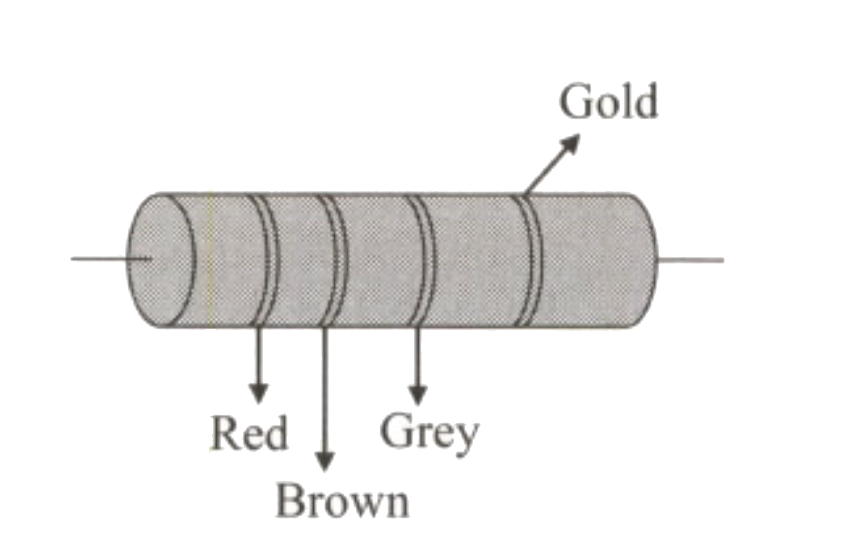Write the sequence of colours in a carbon resistor having resistances 25×106Ω±10%. How will the sequence change if the tolerance becomes 20%?
To determine the sequence of colors in a carbon resistor with a resistance of 25×106Ω±10%, we will follow the standard color coding for resistors.
1. Identify the Resistance Value:
The resistance value given is 25×106Ω. This can be expressed as 25 (the significant figures) and 106 (the multiplier).
2. Break Down the Significant Figures:
The significant figures 25 can be broken down into two digits:
- The first digit is 2.
- The second digit is 5.
3. Determine the Color for Each Digit:
Using the resistor color code:
- The color for the digit 2 is Red.
- The color for the digit 5 is Green.
4. Determine the Multiplier:
The multiplier is 106. According to the color code:
- The color for 106 is Blue.
5. Determine the Tolerance:
The tolerance given is 10%. In the color code:
- A tolerance of 10% is represented by Silver.
6. Combine the Colors:
Now, we can combine the colors for the resistor:
- First digit (2): Red
- Second digit (5): Green
- Multiplier (10^6): Blue
- Tolerance (10%): Silver
Therefore, the sequence of colors for the resistor is:
Red, Green, Blue, Silver.
Change in Tolerance to 20%:
1. Identify the New Tolerance:
If the tolerance changes to 20%, we refer to the color code again.
2. Determine the Color for 20% Tolerance:
In the resistor color code, a tolerance of 20% does not have a specific color associated with it. It is typically represented by the absence of any color.
3. Combine the Colors with New Tolerance:
The sequence of colors now becomes:
- First digit (2): Red
- Second digit (5): Green
- Multiplier (10^6): Blue
- Tolerance (20%): No Color
Therefore, the new sequence of colors for the resistor with 20% tolerance is:
Red, Green, Blue (with no color for tolerance).
Final Answer:
- For 25×106Ω±10%: Red, Green, Blue, Silver
- For 25×106Ω±20%: Red, Green, Blue
The resistance value given is 25×106Ω. This can be expressed as 25 (the significant figures) and 106 (the multiplier).
The significant figures 25 can be broken down into two digits:
- The first digit is 2.
- The second digit is 5.
Using the resistor color code:
- The color for the digit 2 is Red.
- The color for the digit 5 is Green.
The multiplier is 106. According to the color code:
- The color for 106 is Blue.
The tolerance given is 10%. In the color code:
- A tolerance of 10% is represented by Silver.
Now, we can combine the colors for the resistor:
- First digit (2): Red
- Second digit (5): Green
- Multiplier (10^6): Blue
- Tolerance (10%): Silver
Red, Green, Blue, Silver.
If the tolerance changes to 20%, we refer to the color code again.
In the resistor color code, a tolerance of 20% does not have a specific color associated with it. It is typically represented by the absence of any color.
The sequence of colors now becomes:
- First digit (2): Red
- Second digit (5): Green
- Multiplier (10^6): Blue
- Tolerance (20%): No Color
Red, Green, Blue (with no color for tolerance).
- For 25×106Ω±10%: Red, Green, Blue, Silver
- For 25×106Ω±20%: Red, Green, Blue
Topper's Solved these Questions
- CURRENT ELECTRICITYBOOK - MODERN PUBLICATIONCHAPTER - CURRENT ELECTRICITYEXERCISE - Objective Type Questions (MULTIPLE CHOICE QUESTIONS) (NCERT EXEMPLAR PROBLEMS)
11 Videos
- ATOMS BOOK - MODERN PUBLICATIONCHAPTER - ATOMS EXERCISE - Chapter Practice Test
16 Videos
- DUAL NATURE OF RADIATION AND MATTER BOOK - MODERN PUBLICATIONCHAPTER - DUAL NATURE OF RADIATION AND MATTER EXERCISE - CHAPTER PRACTICE TEST
15 Videos
Similar Questions
Write the sequence of coloours in a carbon resistor having resistance 25×106Ω±10% .
View SolutionThe colour code for a carbon resistor of resistance 0.28kΩ±10% -is
View SolutionWhat will be the bands of colours in sequence on carbon resistor, if its resistance is 0.1Ω±5%.
View SolutionWhat is the colour of the third band of a coded resistor of resistance 2.3×102Ω?
View SolutionThe colour sequence in a carbon resistor is yellow, blue and green. Its resistance is 46×105Ω
View SolutionThe resistance of the given carbon resistor is (24×106±5%)Ω. What is the sequence of colours on the strips provided on resistor?
View SolutionHow will you repersent a resistance of 3700Ω±10% by colour code?
View SolutionWhat is the colour code for a resistor of resistance 3.5kΩ with 5% tolerance ?
View SolutionDraw a colour code for 42k Ω±10% carbon resistance.
View SolutionThe value of the resistance of a carbon resistor having the standard colour - coding as shown in the figure is nGΩ±5%. What is the value of n ?

View Solution
